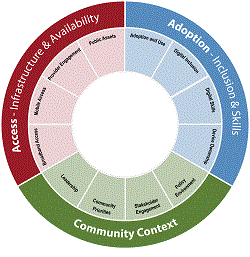Community Connectivity Framework
 |
The Community Connectivity Framework provides a structured approach to explore the factors that promote broadband connectivity and tech-savvy communities. The framework is organized into 12 modules across three sectors, with each module helping leaders explore questions related to broadband availability, adoption and use, and community priorities. |
Access — Broadband Infrastructure and Availability
- Broadband Access: What broadband services are available in your area (e.g., wireline and fixed mobile)?
- Mobile Access: What cellular technology and coverage is available in your area?
- Provider Engagement: Are there opportunities to further strengthen partnerships with existing and new service providers?
- Public Assets: How do local policies support the use of public assets, enhance advanced telecommunications and serve the public good?
Adoption — Digital Inclusion and Workforce Skills
- Adoption and Use: Who is using the Internet? Are there digital divides?
- Digital Inclusion: What proactive measures are you taking to ensure digital inclusion?
- Digital Skills: Do programs provide an opportunity for residents to gain digital proficiencies - from basics to coding?
- Device Ownership: Do people have access to the devices they need to learn, create and participate?
Community — Leadership and Context
- Leadership: How is your community organized to take action and improve broadband?
- Community Priorities: What issues draw you to take action to improve broadband?
- Stakeholder Engagement: Who are your stakeholders? Which stakeholders have interest or influence on your broadband project?
- Policy Environment: Are there regional or state resources or regulations that impact local planning and investment?
